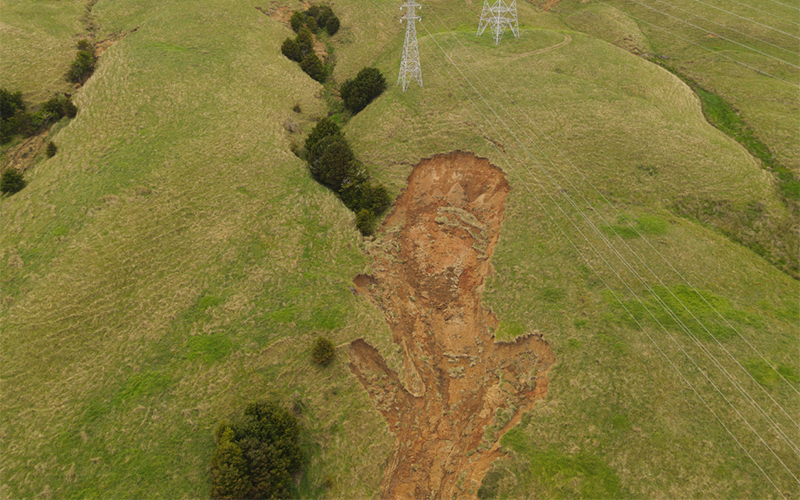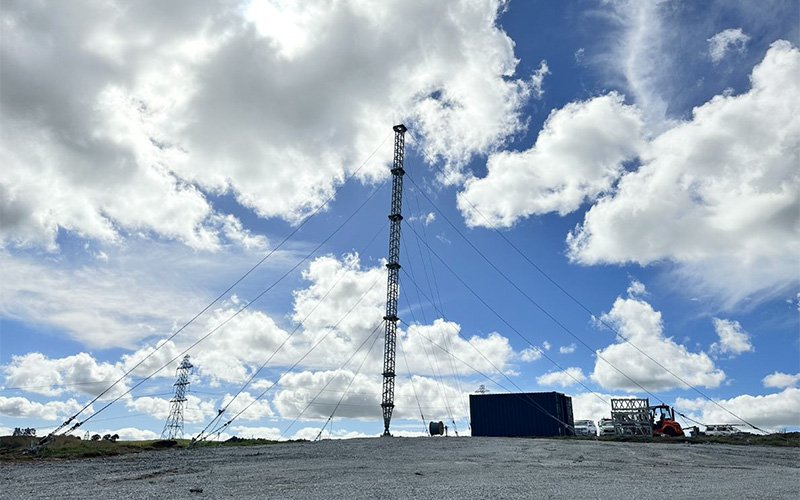16 Jun 2023
Tropical Cyclone Gabrielle was an historic event, causing widespread damage and the tragic loss of 11 lives. Simon Carter, a Service Delivery Manager and 13-year Transpower veteran, shares his experience of rerouting vital transmission lines that were threatened by landslips following the storm.
Simon manages transmission line maintenance for Auckland and Northland, as well as the contract for emergency structures for the whole North Island. So the first order of business after Cyclone Gabrielle was inspecting the network.
A lot of slips were identified, but nothing seemed particularly concerning until a helicopter patrol identified a large slip just downhill from two key pylons. One carries a 220 kilovolt (kV) line from Henderson to Marsden Point, while the smaller carries the 110kV line from Henderson to Maungatapere.

The landslip as it appeared upon initial inspection of the site. Photo: Simon Carter
“At first the slip didn’t seem that worrying,” Simon said. “We saw quite a few similar slips all over Northland, some just as close to the towers or even closer. But what really caught our attention were the insulators. They’re supposed to be vertical, but these were hanging out to the side, which told us straight away that the towers had moved.”
We were fairly concerned about the risk to supply – on these lines were four circuits which constitute all of Northland’s power.
Once onsite, Simon and his contractors quickly found evidence the visible slip wasn’t the main threat to the towers. “We found cracks in the earth around the entire site, which told us that whole piece of land had shifted by a metre or more,” Simon said.
“We were fairly concerned about the risk to supply – on these lines were four circuits which constitute all of Northland’s power,” Simon said. “And we got thrown every curveball with this one. Part of what made this site so difficult is that the lines from each tower cross over nearby, with a really long 500 metre span on the other side, and all with difficult access.”
The 110kV tower was more at risk, while the 220kV tower was more important to maintaining Northland’s power supply. So the decision was made to disconnect the lines from the smaller tower to make it safer and easier to work on the larger one.
“That allowed us to focus on the most critical part of the response, which was getting the 220kV line onto a new, safe route, away from this location that’s at risk,” Simon said. To achieve this, emergency structures were required.
Called ‘Lindsey towers’, the emergency structures are slender, vertical trusses, anchored to the ground with an array of guidewires. They can be quickly deployed to reroute transmission lines until a more permanent solution is found.

One of the Lindsey towers that was used to reroute key transmission lines. Photo: Simon Carter
“We train on them regularly, but we haven’t needed to use these structures as part of an emergency response since 2005,” Simon said. “And Transpower actually had a project wrapping up recently to improve how we store and deploy them, where we pack everything we need to put up one tower into two shipping containers – so we can just put them on a truck and go. That definitely made it all happen faster and more efficiently, which was awesome.”

Installing one of the Lindsey towers. Photo: Simon Carter
It took about four weeks to go from identifying the risk to the pylons to having transferred all key circuits onto the Lindsey towers, and Simon now has some breathing room. Work continues to stabilise other slips across the network and the process to select a new site for the permanent replacement pylons has begun.
Simon emphasised that the response was very much a team effort. “We had a fairly significant cast of engineering and other talent involved from across the industry and everyone pulled together. Massive credit to our team and all the contractors and subcontractors who made it possible,” he said.
“The landowner was also fantastic. They understood how important it was and gave us all the room we needed to get the work done.”





